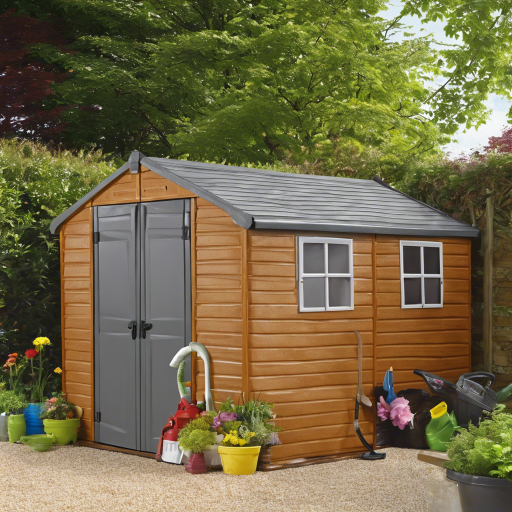plastic garden shed clearance
The Ultimate Guide to Plastic Garden Shed Clearance
Are you tired of clutter in your garden? Do you have an old, unused plastic garden shed taking up valuable space? It's time to take back control of your outdoor area by clearing out and making way for a fresh start. In this guide, we'll walk you through the process of plastic garden shed clearance, from assessing the shed's condition to finding eco-friendly disposal options. Let's get started!
Assessing Your Plastic Garden Shed
The first step in plastic garden shed clearance is to assess the condition of your shed. Carefully examine the structure to determine whether it is salvageable or beyond repair. Ask yourself the following questions:
- Are there any major cracks, holes, or damages?
- Is the shed missing any essential parts, such as doors or windows?
- Is the roof leaking or deteriorating?
- Does the shed have a strong, stable foundation?
If you answer "yes" to any of these questions, it might be time to consider replacing your shed instead of clearing it out. However, if the shed is in good condition overall, it's time to roll up your sleeves and start the clearance process.
Preparing for Plastic Garden Shed Clearance
Before diving into the shed clearance, it's important to gather the necessary tools and supplies to make the process easier and more efficient. Here's a list of items you may need:
- Protective Gear: Wear gloves, safety goggles, and a mask to protect yourself from dust and potential hazards.
- Cleaning Supplies: Gather brooms, dustpans, brushes, and garbage bags to clean and dispose of the shed's contents.
- Organization Tools: Consider using plastic storage bins and labeling them for easy organization during the clearance process.
Organizing and Sorting
Now that you've gathered your supplies, it's time to organize and sort the items inside your plastic garden shed. Start by removing everything from the shed and placing them in an open area, such as your lawn or patio. Create designated piles for items you want to keep, donate, sell, or dispose of.
- Keep: Sort through your belongings and decide what you genuinely need and use. Only keep items that are in good condition and serve a purpose in your garden.
- Donate: If you have items that are still usable but no longer serve your needs, consider donating them to local charities or community centers.
- Sell: If you come across items that are in good condition but no longer have a place in your garden, consider selling them online or hosting a yard sale. This way, you can make some extra money while decluttering.
- Dispose: For items that are broken, damaged beyond repair, or no longer functional, it's important to dispose of them responsibly.
Eco-Friendly Disposal Options
When it comes to disposing of your plastic garden shed, it's crucial to choose environmentally friendly options. Here are some eco-friendly disposal methods to consider:
- Recycling: If your shed is made of recyclable plastic, contact your local recycling center for guidance on how to recycle it properly. They may require you to disassemble the shed or have specific drop-off locations.
- Upcycling: Get creative and repurpose parts of your shed for other projects. You can turn the shed's doors into wall decor, use the panels for compost bins, or transform the materials into raised garden beds.
- Hire a Professional: If you're unable to dispose of the shed on your own or it's beyond repair, consider hiring professional junk removal services that specialize in eco-friendly disposal. These companies ensure that your shed and its materials are disposed of responsibly and recycled whenever possible.
Cleaning and Maintenance
Once the shed is cleared out and the unwanted items are disposed of, it's time to clean and maintain your plastic garden shed. Follow these steps for a fresh and ready-to-use shed:
- Dust and Sweep: Use a broom or brush to remove dirt, dust, and cobwebs from all surfaces.
- Wash the Shed: Use soapy water and a soft brush or sponge to wash the shed's interior and exterior. Rinse thoroughly to remove any residue.
- Inspect for Damages: Take this opportunity to identify any damages or weaknesses in the shed's structure. Repair or replace any broken or loose parts to ensure its longevity.
- Consider Improvements: If you want to maximize the space and functionality of your shed, think about adding shelving, hooks, or additional storage options.
Organizing Your Plastic Garden Shed
To avoid clutter and maintain an organized space, it's important to implement a system for organizing your plastic garden shed. Here are a few tips to help you stay organized:
- Categorize: Sort similar items together to make them easier to find when needed. For example, store gardening tools in one section and pots and planters in another.
- Label Everything: Use labels or markers to identify the contents of storage containers and shelves. This makes it easier to quickly locate items without rummaging through boxes.
- Utilize Wall Space: Install hooks, racks, or pegboards on the shed's walls to hang small tools, hoses, or other accessories.
- Maximize Vertical Space: Consider adding shelves or stacking storage containers to optimize vertical space in your shed.
By following these organization tips, you'll be able to maintain a tidy and functional plastic garden shed all year round.
Conclusion
Clearing out a plastic garden shed is a refreshing and rewarding task that transforms your outdoor space into an organized and clutter-free area. Remember to assess the condition of the shed before deciding to clear it out or replace it. Organize and sort your belongings, making sure to responsibly dispose of unwanted items. Clean and maintain your shed, and implement an organizational system to keep it organized moving forward. Now, you're ready to enjoy your rejuvenated plastic garden shed and fully utilize its potential. Happy gardening!


